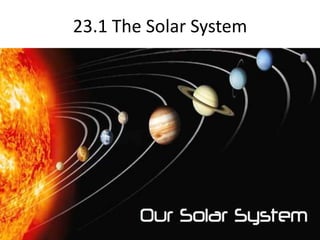Recommended
Recommended
More Related Content
What's hot
What's hot (19)
Lesson 1 the origin of the universe and solar system

Lesson 1 the origin of the universe and solar system
More from Tamara
More from Tamara (20)
Earth science 23.1
- 1. 23.1 The Solar System
- 2. Terrestrial Planet Any of the Earth-like planets, including Mercury, Venus, Mars, and Earth.
- 3. Jovian Planet The Jupiter-like planets; Jupiter, Saturn, Uranus, and Neptune; These planets have relatively low densities and are huge gas giants.
- 4. Nebula A cloud of gas and/or dust in space.
- 5. Planetesimal Small, irregularly shaped body formed by colliding matter.
- 6. Key Concept Size is the most obvious difference between the terrestrial and the Jovian planets.
- 7. Key Concept Density, Chemical makeup, and rate of rotation are other ways in which the two groups of planets differ.
- 8. Key Concept According to the nebular theory, the sun and planets formed from a rotating disk of dust and gases.
